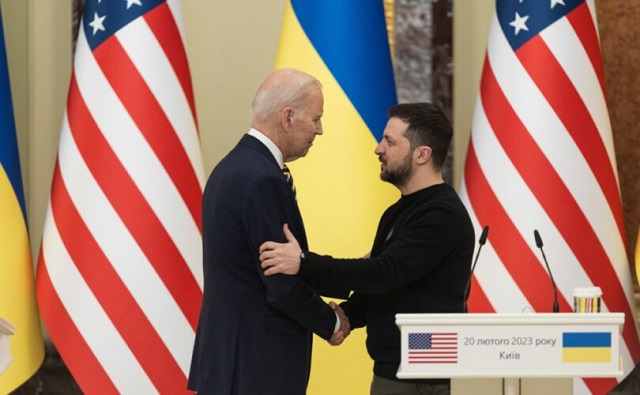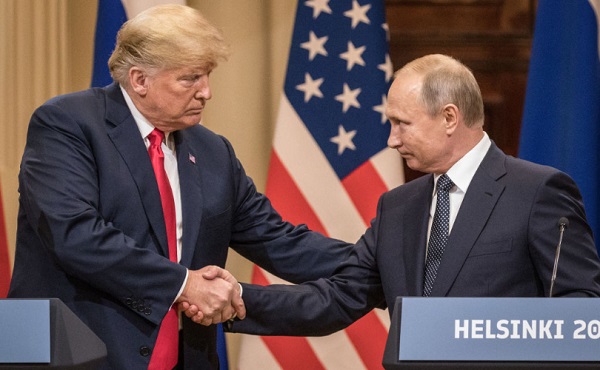conflict
Biden gives green light for Ukraine to shoot US-provided missiles into Russian territory

From LifeSiteNews
This is a major escalation of NATO engagement, likely intended to provoke Russia to strike alternate targets.
According to Politico and the New York Times the Biden administration has given Ukraine approval to launch U.S.-provided missiles into Russia. This is a major escalation of NATO engagement, likely intended to provoke Russia to strike alternate targets. The people inside Ukraine responsible for using these U.S. provided weapons are likely not Ukrainian.
CTH is in an unusually serendipitous position to analyze how Russia is responding to this shift in U.S. position. The morale inside Russia is very high amid the military-age population. The recruitment efforts of the Russian government appear to be numerous and very effective.
There are thousands of newly enlisted military personnel very visible in/around training facilities. There is no apparent tension discernable. Overall Russia appears to take great pride in their military, and it is considered a matter of honor and pride to support them.
From Politico:
The Biden administration has quietly given Ukraine permission to strike inside Russia – solely near the area of Kharkiv – using U.S.-provided weapons, two U.S. officials and two other people familiar with the move said Thursday, a major reversal that will help Ukraine to better defend its second-largest city.
‘The president recently directed his team to ensure that Ukraine is able to use U.S. weapons for counter-fire purposes in Kharkiv so Ukraine can hit back at Russian forces hitting them or preparing to hit them,’ a U.S. official said, adding that the policy of not allowing long-range strikes inside Russia ‘has not changed.’
… In effect, Ukraine can now use American-provided weapons, such as rockets and rocket launchers, to shoot down launched Russian missiles heading toward Kharkiv, at troops massing just over the Russian border near the city, or Russian bombers launching bombs toward Ukrainian territory. But the official said Ukraine cannot use those weapons to hit civilian infrastructure or launch long-range missiles, such as the Army Tactical Missile System, to hit military targets deep inside Russia.
It’s a stunning shift the administration initially said would escalate the war by more directly involving the U.S. in the fight. But worsening conditions for Ukraine on the battlefield – namely Russia’s advances and improved position in Kharkiv – led the president to change his mind.
You can tell from the general vibe amid the officials of government, Russia is not playing around with their military approach toward previous NATO encroachment or the provocations by the U.S. The sense is that Russia is in this for the long haul and their structural changes in the aftermath of the sanction regime are not temporary. Russians overall are hard and resilient to the reality of things as they are, not as they would wish them to be.
Russia appears to be entirely prepared financially, sociologically, and economically to remain disconnected from the “West.” Asia and India are filling the economic void created by Western sanctions. Amid ordinary life, the general Russian sentiment seems to be one of acceptance to the geopolitical isolation.
In recent weeks, the push toward further conflict with Russia seemed to be diminishing; however, this direct action by Biden and the State Dept. puts the U.S. (NATO) in a more aggressive posture.
Hungarian Prime Minister Viktor Orbán opposes the escalation by NATO:
During a Friday interview on state radio, Orbán said that French President Emmanuel Macron’s stance that he wouldn’t rule out sending troops to Ukraine, as well as a NATO proposal that would allow Kyiv to strike military bases inside Russia with sophisticated long-range weapons provided by Western partners, risked escalating the war in Ukraine into a global conflict.
‘War is a monster that is constantly hungry, it must be fed, and it must be fed with money. And I see that the Americans and the Democratic government of the United States, and the leaders of the European Union, are ready to feed it,’ he said.
Reprinted with permission from the Conservative Treehouse.
conflict
US airstrike on Iran’s nuclear facilities. Was it obliteration?

A satellite image of the Isfahan nuclear research center in Iran shows visible damage to structures and nearby tunnel entrances from recent US airstrikes. / Satellite image (c) 2025 Maxar Technologies.
 Seymour Hersh
Seymour Hersh
The US attack on Iran may not have wiped out its nuclear ambitions but it did set them back years
I started my career in journalism during the early 1960s as a reporter for the City News Bureau of Chicago, a now long-gone local news agency that was set up by the Chicago newspapers in the 1890s to cover the police and fire departments, City Hall, the courts, the morgue, and so on. It was a training ground, and the essential message for its aspiring reporters was: “If your mother says she loves you, check it out.”
It was a message I wish our cable networks would take to heart. CNN and MSNBC, basing their reporting on an alleged Defense Intelligence Agency analysis, have consistently reported that the Air Force raids in Iran on June 22 did not accomplish their primary goal: total destruction of Iran’s nuclear-weapons capacity. US newspapers also joined in, but it was the two nominally liberal cable channels, with their dislike—make that contempt—for President Donald Trump, that drove the early coverage.
There was no DIA analysis per se. All US units that engage in combat must file an “after-action report” to the DIA after a military engagement. In this case, the report would have come from the US Central Command, located at MacDill Air Force base in Tampa, Florida. CENTCOM is responsible for all US military operations in the Middle East, Egypt, Central Asia, Afghanistan, and Pakistan. One US official involved in the process told me that “the first thing out of the box is you have to tell your boss what happened.” It was that initial report of the bombing attack that was forwarded to DIA headquarters along the Potomac River in Washington and copied or summarized by someone not authorized to do so and sent to the various media outlets.
The view of many who were involved in the planning and execution of the mission is that the report was summarized and leaked “for political purposes”—to cast immediate doubt on the success of the mission. The early reports went so far as to suggest that Iran’s nuclear program has survived incapacitation by the attack. Seven US B-2 “Spirit” bombers, each carrying two deep-penetration “bunker-busters” weighing 30,000 pounds, had flown without challenge from their base in Missouri to the primary target: Iran’s Fordo nuclear facility, concealed deep inside a mountain twenty miles north of the city of Qom.
The planning for the attack began with the knowledge that the main target—the working area of the nuclear program—was buried at least 260 feet below the rocky surface at Fordo. The gas centrifuges spinning there were repeatedly enriching uranium, in what is known as a cascade, not to weapons-grade level—uranium-235 isotopes enriched to 90 percent—but to 60 percent. Further processing to create weapons grade uranium, if Iran chose to do so, could be done in a matter of weeks, or less. The Air Force planning group had also been informed before the bombing raid, most likely by the Israelis, who have a vast spy network in Iran, that more than 450 pounds of the enriched gas stored at Fordo had been shipped to safety at another vital Iranian nuclear site at Isfahan, 215 miles south of Tehran. Isfahan was the only known facility in Iran capable of converting the Fordo gas into a highly enriched metal—a critical early stage of building the bomb. Isfahan also was a separate target of the US attack on Fordo, and was pulverized by Tomahawk missiles fired by a U.S. submarine operating in the Gulf of Aden, off Yemen.
As a journalist who for decades has covered the nascent nuclear crisis in the Middle East, it seemed clear to me and to informed friends I have in Washington and Israel that if Fordo somehow survived its bunker-buster attack, as was initially suggested, and continued to enrich more uranium, Isfahan would not. No enrichment, no Iranian bomb.
I’ve been frustrated and angry at cable news coverage for years, and that includes Fox News, too, and decided to try and find the real story. If your mother says she loves you, check it out. And I checked out enough of it to share.
I was told that “the first question for the American planners was how big was the actual workspace at Fordo? Was it a structure? We had to find that out before we got rid of it.” Some of the planners estimated that the working space “was the size of two hockey rinks: 200 feet long and 85 feet wide.” It came to 34,000 square feet. The height of the underground working space was assumed to be ten-and-a-half feet—I was not told the genesis of that assumption—and the size of the target was determined to be 357,000 cubic feet.
The next step was to measure the power of the dozen or more bunker-busters that were planned to be “carefully spaced and dropped” by the US B-2 bombers, using the most advanced guidance systems. (During one high-level session in Washington, one of the Air Force planners was asked what would happen if the B-2’s guidance systems were corrupted by an outside signal. “We’d miss the target” was the answer.)
I was assured that even if the rough estimate of the working space at Fordo was far off, the bombers targeting Fordo each carried a 30,000-pound bomb with an explosive payload of as much as five thousand pounds, which was more than enough to pulverize the mythical hockey rinks, or even a much larger working space.
Some of the bombs were also outfitted with what is known as a hard target void sensing fuze, which enabled the bombs to penetrate multiple layers of a site like Fordo before detonating. This would maximize the destructive effect. Each bomb, dropped in sequence, would create a force of rubble that would cause increasing havoc in the working areas deep inside the mountain.
“The bombs made their own hole. We built a 30,000-pound steel bullet,” the official told me, referring with pride to the bunker-busters.
Most important, he said, was that there were no post-strike hints detected of radioactivity—more evidence that the 450 pounds of enriched uranium had been moved from Fordo to the reprocessing site at Isfahan prior to the US attack there, which was code-named “Midnight Hammer.” That operation included a third US strike at yet another nuclear facility at Natanz.
“The Air Force got everything on the hit list,” the official told me. “Even if Iran rebuilds some centrifuges, it will still need Isfahan. There is no conversion capability without it.”
Why not, I asked, tell the public about the success of the raid and the fact that Iran no longer has a potential nuclear weapon?
The answer: “There will be a top-secret report about all of this, but we don’t tell people how hard we work. We tell the public what we think it wants to hear.”
The US official, asked about the future of the Iranian nuclear program, quickly acknowledged that “there is a communication problem” when it comes to the fate of the program.
The intent of the strike planners, he said, “was to prevent the Iranians from building a nuclear weapon in the near term—a year or so—with the hope they would not try again. The clear understanding was that there was no expectation to ‘obliterate’ every aspect of their nuclear program. We don’t even know what that is.
“Obliteration means the glass—[eliminating] Iran’s nuclear program—is full. The planning and the results are the glass is half-full. For Trump critics, the results are the glass is half-empty—the centrifuges may have survived and four hundred pounds of 60 percent enriched uranium are missing. The bombs could not be assured to penetrate the centrifuge chamber . . . too deep, but they could cover them up [with rocks and other bomb debris] and in the process cause unknown damage to them.
“Whether the 60 percent [enriched uranium] was there or not is irrelevant because without centrifuges they cannot refine it to weapons grade. Add to this the research and refinement and conversion from gas to metal—required for a bomb—at Isfahan are also gone.
“Results? Glass is half-full . . . a couple of years of respite and uncertain future. So now Trump’s defense is Full Glass. Critics? Half-empty. Reality? Half-full. There you are.”
The immediate beneficiary of the use of US force in Iran will not be a more placid Middle East, but Israel, and Prime Minister Benjamin Netanyahu. The Israeli Air Force and army are still killing massive numbers of Palestinians in Gaza.
There remains no evidence that Iran was on the cusp of becoming a nuclear power. But as the world has known for decades, Israel maintains a significant nuclear arsenal that it officially claims does not exist.
This is a story not about the bigger picture, which is muddled, but about a successful US mission that was the subject of a lot of sloppy reporting because of a reviled president. It would have been a breakthrough had anyone in the mainstream press spoken or written about the double standard that benefits Israel and its nuclear umbrella, but in America that remains a taboo.
Subscribe to Seymour Hersh.
For the full experience, upgrade your subscription.
conflict
Obama Dropped Over 26K Bombs Without Congressional Approval

@miss_stacey_ Biden, Clinton, Obama & Harris on Iran #biden #clinton #obama #harris #trump #iran #nuclear
Iran has been the target for decades. Biden, Harris, and Clinton—all the Democrats have said that they would attack Iran if given the opportunity. It appears that Donald Trump is attempting to mitigate a potentially irresolvable situation. As he bluntly told reporters: We basically — we have two countries that have been fighting so long and so hard that they don’t know what the f‑‑‑ they’re doing.”
A portion of the nation believes Trump acted like a dictator by attacking Iran without Congressional approval. I explained how former President Barack Obama decimated the War Powers Resolution Act when he decided Libya was overdue for a regime change. The War Powers Act, or War Powers Resolution of 1973, grants the POTUS the ability to send American troops into battle if Congress receives a 48-hour notice. The stipulation here is that troops cannot remain in battle for over 60 days unless Congress authorizes a declaration of war. Congress could also remove US forces at any time by passing a resolution.
Libya is one of seven nations that Obama bombed without Congressional approval, yet no one remembers him as a wartime president, as the United States was not technically at war. Over 26,000 bombs were deployed across 7 nations under his command in 2016 alone. Libya, Afghanistan, Syria, Yemen, Somalia, Iraq, and Pakistan were attacked without a single vote. Donald Trump’s recent orders saw 36 bombs deployed in Iran.
The majority of those bombings happened in Syria, Libya, and Iraq under the premise of targeting extremist groups like ISIS. Drone strikes were carried out across Somalia, Yemen, and Pakistan as the Obama Administration accused those nations of hosting al-Qaeda affiliated groups. Coincidentally, USAID was also providing funding to those groups.
The 2001 Authorization for Use of Military Force (AUMF) was initially implemented to hunt down the Taliban and al-Qaeda after the 9/11 terrorist attacks. Obama broadened his interpretation of the AUMF and incorporated newly formed militant groups that were allegedly expanding across the entire Middle East. The Bureau of Investigative Journalism believes there were up to 1,100 civilian casualties in Pakistan, Yemen, and Somalia. Thousands of civilians died in Syria and Iraq but the death toll was never calculated. At least 100 innocent people died in the 2016 attacks in Afghanistan alone.
The government will always augment the law for their personal agenda. The War Powers Resolution was ignored and the AUMF was altered. Congress was, however, successful in preventing Obama from putting US troops on the ground and fighting a full-scale war. In 2013, Obama sought congressional approval for military action in Syria but was denied. Obama again attempted to deploy troops in 2015 but was denied. Congress has to redraft the AUMF to specifically prevent Obama from deploying troops in the Middle East. “The authorization… does not authorize the use of the United States Armed Forces on the ground in Syria for the purpose of combat operations.” Obama attempted to redraft the AUMF on his own by insisting he would prohibit “enduring offensive ground combat operations” or long-term deployment of troops. He was met with bipartisan disapproval as both sides believed he was attempting to drag the United States into another unnecessary war.
The United States should not be involved in any of these battles, but here we are. Those living in fear that Donald Trump is a dictator fail to recognize that past leadership had every intention of sending American men and women into battle unilaterally without a single vote cast.
-

 Environment2 days ago
Environment2 days agoEPA releases report on chemtrails, climate manipulation
-

 Crime2 days ago
Crime2 days agoSweeping Boston Indictment Points to Vast Chinese Narco-Smuggling and Illegal Alien Labor Plot via Mexican Border
-

 Business2 days ago
Business2 days agoUN’s ‘Plastics Treaty’ Sports A Junk Science Wrapper
-

 Business1 day ago
Business1 day agoCBC six-figure salaries soar
-

 Addictions1 day ago
Addictions1 day agoMore young men want to restrict pornography: survey
-

 International1 day ago
International1 day agoSupport for the Ukraine war continues because no one elected is actually in charge.
-

 Business1 day ago
Business1 day agoTrump slaps Brazil with tariffs over social media censorship
-

 Business1 day ago
Business1 day agoTrump confirms 35% tariff on Canada, warns more could come








